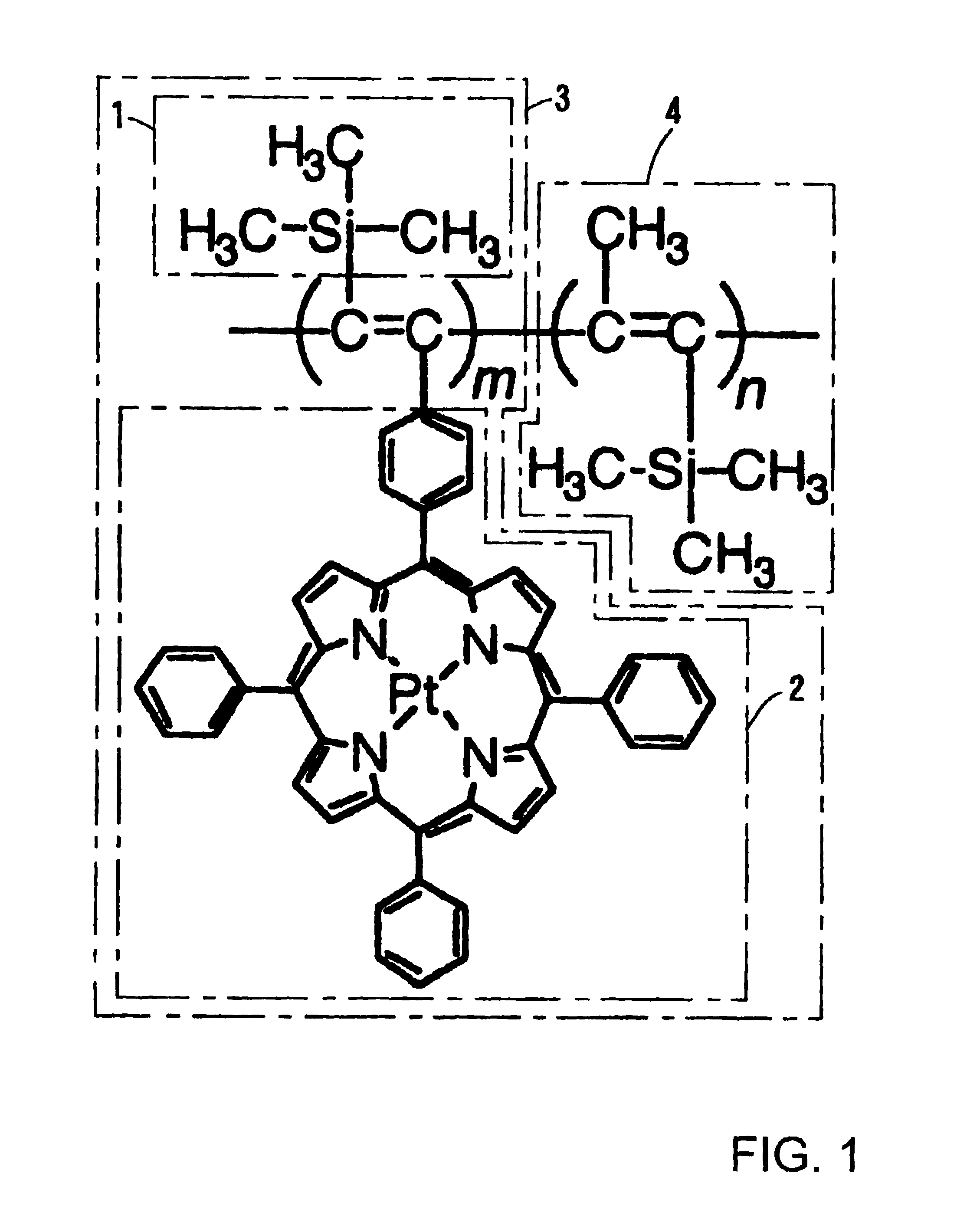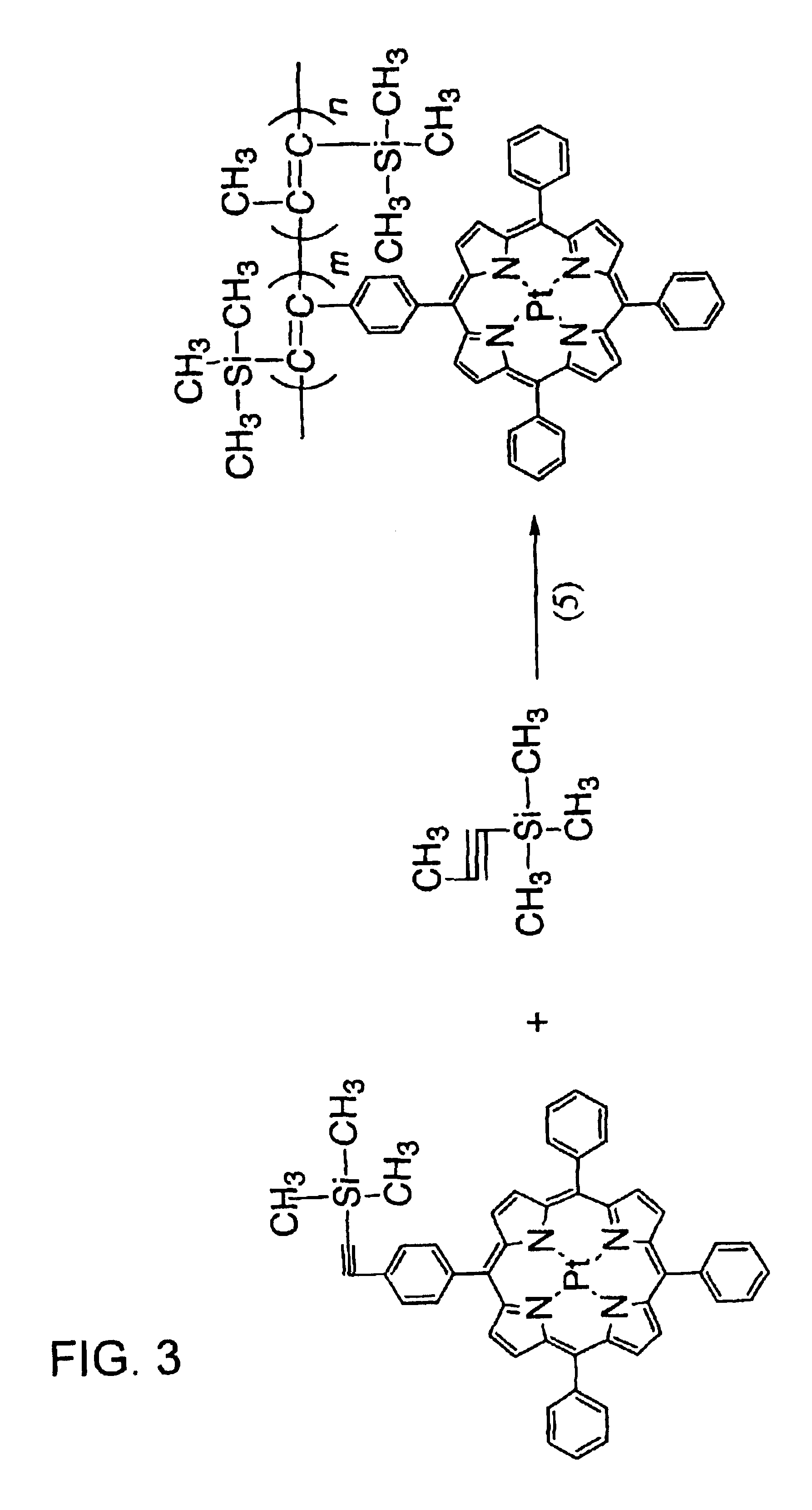Functional polymer with supported pressure-sensitive luminophore, and pressure-sensitive paint and pressure-sensitive element using same
a technology of luminophore and polymer, which is applied in the direction of fluorescence/phosphorescence, instruments, transportation and packaging, etc., can solve the problems of inability to say which specimen would be better for conducting operations, and inability to respond temporally to pressure variations
- Summary
- Abstract
- Description
- Claims
- Application Information
AI Technical Summary
Benefits of technology
Problems solved by technology
Method used
Image
Examples
synthesis example 2
5-(4-Trimethylsilyl ethynyl phenyl)-10,15,20-triphenyl platinum porphyrin and 1-trimethylsilyl-1-propyne (TMSP) were copolymerized using tantalum chloride as a catalyst in accordance with reaction (5) in FIG. 3. Specifically, 12 mL of toluene was introduced into a nitrogen-replaced reaction vessel, which was then purged with nitrogen gas for 30 minutes. 0.5 mL of TMSP was injected with a syringe, the nitrogen aeration was continued under heating, and the system was slowly heated to 90.degree. C. over a period of 20 minutes. 80 mg of titanium chloride and, 30 minutes later, 80 mg of 5-(4-trimethylsilyl ethynyl phenyl)-10,15,20-triphenyl platinum porphyrin were added, and the system was heated to 90.degree. C. and allowed to react for 1 day. A polymer settled out when the reaction solution was added in drops to 1 L of methanol under stirring. The precipitate was filtered off and dried. The product was re-dissolved in a small amount of toluene, and the catalyst-containing impurities we...
synthesis example 3
Reacting aminopyrene instead of the pyrrole and benzaldehyde in synthesis process (3) in FIG. 2 yields 4-trimethylsilylethylene benzylidene iminopyrene, and pyrene or another oxygen-quenching luminophore can be supported if this compound is subjected to copolymerization.
Poly(1-trimethylsilylpropyne-co-trimethylsilylethynylpyrene) was synthesized in accordance with reactions in FIG. 7, to give a new high-molecular-weight pyrene polymer in FIG. 6. 4-(Trimethylsilyl)ethynylpyrene was prepared by the coupling reaction (6) of 4-bromopyrene with trimethylsilylacetylene in FIG. 7.
A deaerated solution of 2.0 g of 4-bromopyrene and 0.08 g of triphenylphosphine in 25 mL of anhydrous triethylamine was mixed with 2.3 mL of trimethylsilylacetylene and then 0.07 g of palladium(II) acetate was added under nitrogen. The mixture was heated at 85.degree. C. for 2.5 hours. After cooling down, the solvent was removed under a reduced pressure. The residue was purified by the column chromatography by usi...
PUM
| Property | Measurement | Unit |
|---|---|---|
| pressure | aaaaa | aaaaa |
| transparent | aaaaa | aaaaa |
| central wavelength | aaaaa | aaaaa |
Abstract
Description
Claims
Application Information
 Login to View More
Login to View More - R&D
- Intellectual Property
- Life Sciences
- Materials
- Tech Scout
- Unparalleled Data Quality
- Higher Quality Content
- 60% Fewer Hallucinations
Browse by: Latest US Patents, China's latest patents, Technical Efficacy Thesaurus, Application Domain, Technology Topic, Popular Technical Reports.
© 2025 PatSnap. All rights reserved.Legal|Privacy policy|Modern Slavery Act Transparency Statement|Sitemap|About US| Contact US: help@patsnap.com



